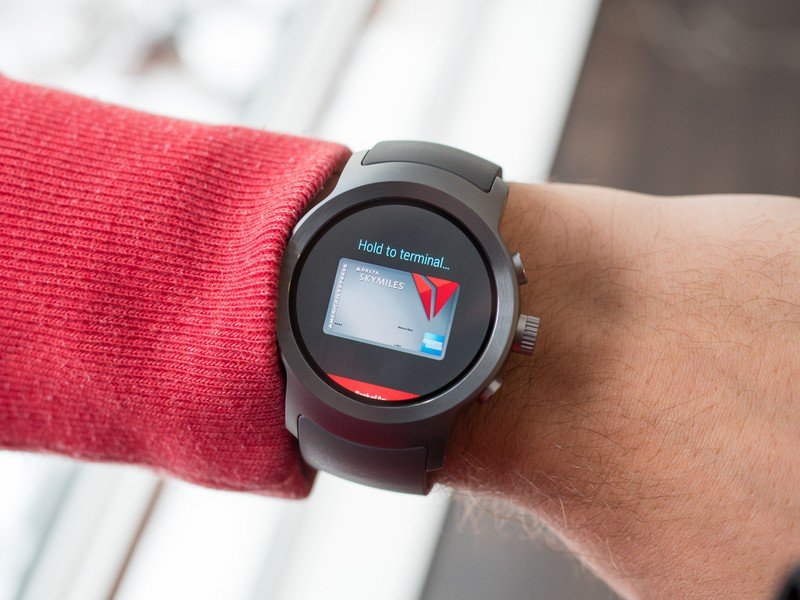Android Pay on Android Wear 2.0 just isn't that good

I was relatively late coming to Android Pay on phones, mainly because my bank was one of the last in the UK to adopt the payment service. But I've gotten in on the ground floor with Pay on Android Wear, and I return with tales from an almost-convenient future where it's nearly really easy to tap and pay with a thing attached to the end of your limb.
Which is another way of saying Pay on Wear isn't quite there yet, for a wide variety of reasons.
The process of setting up Android Pay on your Wear 2.0 smartwatch is a somewhat convoluted series of steps involving bouncing between your phone and your watch — and, in my case, an actual phone call to a human at your bank to finally approve everything.
Then you're ready to go. Except... nope, not yet. You'll need to set a pattern or PIN lock on your watch for security, which makes sense. This sounds incredibly onerous, but in fact you only need to re-enter your pattern when the watch breaks skin contact, so effectively it's only a once-a-day chore.
Next you'll realize that finding Android Pay in the app drawer each time you want to pay is kind of a pain in the ass, so you'll inevitably assign your Watch's custom button (on the LG Watch Sport or Huawei Watch 2) to this app. That's because, unlike Android phones, the app itself needs to be open on the watch when you pay. Pressing a physical button is easier than tapping, swiping and scrolling.

Then comes the moment of truth — actually paying with your watch. The positive and negative outcomes from this endeavor are amplified considerably compared to paying with your phone. You'll feel even more like a wizard from the future when it works. The occasional times when it doesn't, you'll feel like even more of an idiot. Here in the UK, contactless credit and debit cards have been around for the past few years, and the idea of paying with your phone isn't completely alien either. (Though some cashiers still assume it's Apple Pay or nothing.)
Paying for purchases with a smartwatch is still strange and alien to many.
NFC terminals are fairly common in the UK, but the experience of paying with a watch is still new and confusing to many. Maybe that'll change, as it has for contactless cards and phone payments. Then again, given the niche appeal of smartwatches, maybe not.
Be an expert in 5 minutes
Get the latest news from Android Central, your trusted companion in the world of Android
Aside from the conceptual awkwardness of explaining that you want to pay using your watch — and that, yes, that's actually a thing you can do — there's also the physical awkwardness of holding your watch face (on the Huawei Watch 2) or strap (on the LG Watch Sport) up to the terminal. If you're right-handed, and thus wear your watch on your left arm, many payment terminals are on the wrong side for easy reachability. Same deal with NFC contacts for gates on the London Underground. You're also dealing with a relatively small NFC target, so things need to line up just right.
Here's where we run into the gap between theoretical convenience and actual convenience. It seems like it'd be way easier to pay with something that's attached to your body at all times. In practice, it's actually simpler to make the connection using an object you're holding in your hand, because the motion of lining your wrist up just right with the terminal is unexpectedly clunky.
And again, you'll look like even more of an idiot that one time it inevitably doesn't work. Even when it does, the Android Pay app on Wear 2.0 can take its time loading, and occasionally hang altogether. Admittedly, I'm using it on a pre-release Huawei Watch 2, but my colleague Andrew Martonik has experienced similar bugs on a production-quality LG Watch Sport.
Smartwatch payments aren't inherently a bad idea, but it's still early days here. Things aren't as magically convenient as you might expect, and the real world hasn't yet adjusted to the idea of waving your wrist over things to pay. As a taste of the future, Android Pay on Android Wear is neat. As a real-world convenience, not so much.

Alex was with Android Central for over a decade, producing written and video content for the site, and served as global Executive Editor from 2016 to 2022.
